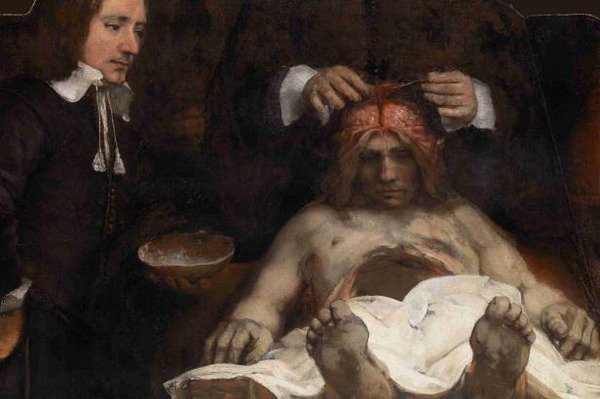The Anatomy Lesson
dal 27/9/2013 al 4/1/2014
Segnalato da
Atelier van Lieshout
Francis Bacon
Berlinde De Bruyckere
Matthew Day Jackson
Lucio Fontana
Mona Hatoum
Paul Thek
Marc Quinn
Damien Hirst
Folkert de Jong
Rembrandt van Rijn
27/9/2013
The Anatomy Lesson
Gemeentemuseum, Den Haag
This is the first exhibition ever to bring together all 10 of the surviving anatomy lesson paintings produced in the Netherlands in the 17th century. The show will give visitors the chance to get right under the skin of their species, through works by artists ranging from Rembrandt to Damien Hirst.

Human anatomy is a subject of inexhaustible interest not only to science, but also to art. For centuries, the human body and its dissection have been popular subjects among artists. Driven by their fascination with the human body and the thirst for knowledge, people knew that it was only by actually looking inside the body that they would ever truly understand human anatomy. This autumn, the Gemeentemuseum Den Haag is mounting a unique exhibition on the subject. Seventeenth-century ‘anatomy lesson’ paintings will be shown side by side with works on similar themes by top international classic modern and contemporary artists. This is the first exhibition ever to bring together all ten of the surviving anatomy lesson paintings produced in the Netherlands in the seventeenth century. It exploits a one-off opportunity: the fact that Rembrandt’s painting The Anatomy Lesson of Dr Nicolaas Tulp is housed at the Gemeentemuseum for the duration of current renovation work at the Mauritshuis. The show will give visitors the chance to get right under the skin of their species, as it were, through works by artists ranging from Rembrandt to Damien Hirst.
The anatomical practice of the seventeenth-century Surgeon’s Guild of Amsterdam symbolises the innovative spirit of the Dutch Golden Age. Dissections of human corpses in the Theater Anatomicum were open not only to medical men; wealthy laymen could also pay to attend. Science, art and commercial acumen went hand in hand to produce an era of unprecedented social and cultural development. But, perhaps most importantly of all, the paintings mark the birth of empirical science. For the first time, people in Europe abandoned the all-encompassing concept of God. The Bible was no longer the sole explanation for everything. People went in search of the tangible reality and, as part of that quest, turned the body inside out.
The exhibition will also feature items drawn from the history of medical science. In addition to surgical instruments, these will include Utrecht University Medical Centre’s world-famous anatomical preparation ‘Child’s head with Turkish cap’. This important preparation is thought to have been made by Frederik Ruysch in around 1700. Ruysch’s collection of anatomical specimens was bought by Tsar Peter the Great of Russia and is now in the State Hermitage Museum in Saint Petersburg, where access to it is difficult.
The imperfections or failures of the human body, the relationship between body and mind, the power of the medical world and the magic of dissection are topics that feature in the classic modern and contemporary sections of the exhibition. The impressive line-up of artists includes great names like Atelier van Lieshout, Francis Bacon, Berlinde De Bruyckere, Matthew Day Jackson, Lucio Fontana, Mona Hatoum, Paul Thek, Marc Quinn and – of course –Damien Hirst. Their work reveals with particular clarity the friction between the divine and the earthly. It includes, for example, Hirst’s installation Sometimes I Avoid People. Consisting of two glass display cases and gas cylinders, the work give visual expression to the modern way of death: a mysterious activity that takes place behind the closed doors of hospital rooms, with results that are disposed of quickly and efficiently.
Specifically for this exhibition, internationally renowned Dutch sculptor Folkert de Jong has created a large installation based on the idea of the Anatomical Theatre. The Primacy of Matter over Thought will form the very heart of the exhibition and will place visitors in the centre of a space in which they will become keenly aware of the fragility of their own existence. Folkert de Jong takes the anatomical theatre as the starting point for an examination of the balance of power between the artwork, the artist and the viewer. Or, in other words, the deed, the perpetrator and the witnesses.
This exhibition is the result of a partnership between the following museums in the Netherlands: the Amsterdam Museum, the Mauritshuis in The Hague, Museum Boerhaave in Leiden and Museum het Prinsenhof in Delft. The project has also involved collaboration with a number of medical institutions: the University Medical Centre in Utrecht, the Academic Medical Centre in Amsterdam and Haaglanden Medical Centre. Folkert de Jong’s installation is sponsored by the Mondriaan Fund.
The exhibition has been realised with the support of pharmaceutical company Roche Nederland.
The exhibition is accompanied by a lavishly illustrated catalogue containing essays by Doede Hardeman, Tim Huisman, Norbert Middelkoop and Laura Stamps (published by Thoth, softcover € 19.95 and hardcover € 24.95).
Image: Rembrandt van Rijn (1606-1669), The Anatomy Lesson of Dr Jan Deijman (fragment), 1656, oil on canvas, 113 x 135 cm, Amsterdam Museum, Amsterdam. (Photo: Amsterdam Museum, Amsterdam)
Opening: 28 September 2013
Gemeentemuseum Den Haag
Stadhouderslaan 41 2517 HV Den Haag, The Netherlands
Hours
Tuesday - Sunday from 11 A.M. - 5 P.M.
Admission
Regular € 14.50
Combination ticket Gemeentemuseum and GEM /
The Hague Museum of Photography € 17.50
Groups > 15 people € 12.50
Youth (under 18 years) Free



